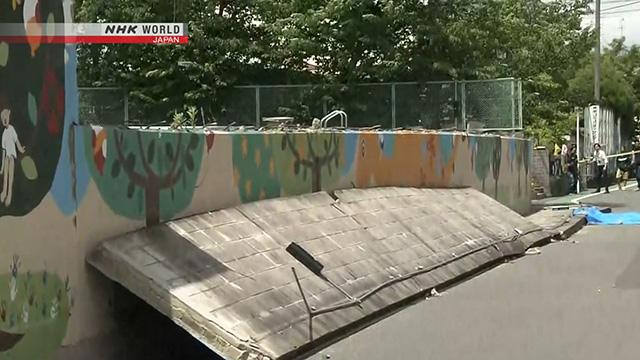Never expected the wall collapse
The earthquake struck just before 8 AM, just as children were on their way to school. At Juei Elementary School in Osaka's Takatsuki City, a wall next to a swimming pool collapsed. The quake there registered an intensity of 6 minus on Japan's seismic intensity scale of zero to seven.
9-year-old Rina Miyake in the 4th grade was killed as she walked by.
Classmates say Rina was kind and well-liked. As a member of the student council, she stood at the school entrance and greeted pupils arriving in the morning.
A woman who lives nearby says children usually head to school around 8 AM but Rina seemed to have left home earlier than usual. A man who lives in the neighborhood says she was adorable and knew how to greet others. He says he's very sad.

Takatsuki City says the wall was built on 8 layers of concrete blocks. It was 3.5 meters from top to bottom. The city's education board says the wall ran alongside a narrow street, known as a "Green Belt," which was designed to ensure the children's safety. The pupils are said to have been told to take the street on their way to and from school.
A man who lives nearby says he never expected the wall to collapse because it looked so sturdy. The city says it hadn't received any complaints about the pool-side wall or any requests to repair or renovate it.
Condolences and apologies
Takatsuki City officials announced on Monday afternoon that the concrete wall didn't comply with Japan's Building Standards Law. The wall had no buttresses to fix blocks to its foundations, and the height of the wall was above the legal construction standard of 2.2 meters. At a press conference, the mayor of Takatsuki City, Takeshi Hamada, apologized for the death of the girl. He offered his heartfelt condolences and apologized for the collapse of the wall.
Dangers of concrete block walls
Professor Masayoshi Saichi of the Tohoku Institute of Technology analyzed images of the collapsed wall and gave his assessment of the dangers it posed.
The city office explained the 1.6-meter-high wall was made up of 8 stacked concrete blocks and erected on top of the pool's 1.9-meter-high foundation. Saichi says the wall is of legal height if the pool's foundation is considered ground level. But he added that the actual ground level should have been taken into account to be on the safe side, considering that children would be near.

Saichi noted that when a strong tremor hits, people seek shelter and try to steady themselves by holding on to a solid structure. He said he doubted city authorities were fully aware of the risk of the wall at the school. He said it looks like the wall had no buttresses to keep it from falling over. He said the way it collapsed indicates it was not properly secured to the foundation in accordance with building codes.
Saichi has studied the damage caused by collapsing concrete block walls since the 1978 earthquake off the coast of Miyagi Prefecture in Japan's northeast. In that earthquake, about 14,000 walls collapsed in Sendai City, and 9 people, including children under primary school age, were fatally crushed.
After that, Japan's Building Standards Law was revised. The building code stipulates that a buttress must be built to provide vertical support for the wall's surface, placed at an interval of 3.4 meters or less, with reinforcing rods embedded from the foundation to the top of the wall.
Saichi said it's not uncommon for earthquakes to topple such walls, making them very dangerous, especially in cities. He expressed regret at the latest disaster, though he has long been warning of the dangers. He cautioned people to stay away from remaining block walls in the areas affected by Monday's earthquake. He said they could have been damaged and may fall over in the next tremor. He says the best thing to do is to remove the concrete block walls entirely. But if this is too difficult, the upper layers should be removed and replaced with aluminum fences.
Police to investigate
Osaka police have begun investigating the site where the 9-year-old girl was fatally crushed.
They will remove the fallen wall to examine its structure. And they'll interview officials from the city and the company that built the wall on suspicion of professional negligence resulting in death.

Education ministry calls for emergency checks
Japan's Education Minister Yoshimasa Hayashi has called for emergency inspections of concrete block walls at elementary and junior high schools across the country.
The education ministry issued the request in response to the disaster in order to quickly grasp the extent of the danger posed by walls nationwide.
